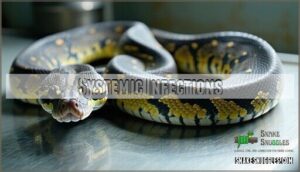This site is supported by our readers. We may earn a commission, at no cost to you, if you purchase through links.
 Ball python skin problems can catch you off guard, but spotting them early makes all the difference.
Ball python skin problems can catch you off guard, but spotting them early makes all the difference.
Watch for red, inflamed patches, blisters, or loose, wrinkled skin that isn’t part of normal shedding. Poor humidity, dirty conditions, and stress often trigger these issues.
Mites, bacterial infections, and retained shed are common culprits that need quick attention. You’ll want to maintain proper humidity levels between 50-60% and keep the enclosure clean.
If your snake’s skin looks dull, has bumps, or won’t shed properly, don’t wait it out. The key signs every owner should recognize can save your snake from serious complications.
Table Of Contents
- Key Takeaways
- Common Skin Problems
- Identifying Skin Issues
- Causes of Skin Problems
- Treatment for Skin Issues
- Preventing Skin Problems
- Shedding Problems
- Respiratory Infections
- Systemic Infections
- Importance of Proper Care
- Maintaining a Healthy Snake
- Frequently Asked Questions (FAQs)
- How do you treat ball python dermatitis?
- How do I know if my ball python has mites?
- What is skin rot on a ball python?
- What does snake skin rot look like?
- How do you treat dermatitis in snakes?
- What do mites look like on ball pythons?
- What are the symptoms of a snake blockage?
- Do ball pythons get sick?
- How do you know if a ball python is healthy?
- Why do ball pythons get sores?
- Conclusion
Key Takeaways
- Watch for red inflamed patches, blisters, retained shed, or tiny moving specks around your snake’s eyes and mouth – these early warning signs help you catch problems before they become serious infections requiring expensive veterinary treatment.
- Maintain humidity levels between 50-60% and clean your snake’s enclosure weekly to prevent bacterial and fungal growth that causes most skin problems, including scale rot and blister disease.
- Don’t attempt home remedies for serious skin issues like abscesses, widespread infections, or respiratory symptoms – these conditions need immediate veterinary care with proper antibiotics and professional treatment.
- Handle your ball python gently during weekly inspections to spot changes in skin texture, color, or shedding problems early, since healthy snakes should shed in one complete piece without stuck skin around toes or tail tips.
Common Skin Problems
Ball pythons can develop several skin problems that you’ll need to recognize quickly for proper treatment.
The most common issues include abscesses, blister disease, parasitic infections from mites and ticks, and shedding disorders that affect your snake’s health and comfort.
Abscess
Abscesses are bacterial time bombs hiding under your ball python’s skin.
These pus-filled lumps develop when injuries or wounds become infected, creating painful swellings that need immediate attention.
Infected wounds become dangerous time bombs – act fast before they explode into serious complications.
Abscess symptoms you’ll notice:
- Location – Head, mouth, or body areas with firm, raised bumps
- Appearance – Red, inflamed tissue that may leak yellowish pus
- Size – Small nodules to large, concerning swellings requiring veterinary treatment
Blister Disease
Sometimes your ball python develops fluid-filled blisters on its scales, a condition called blister disease or scale rot.
These snake skin lesions appear when humidity levels stay too high or from prey bite injuries.
Python scale rot requires immediate attention – reduce enclosure humidity below 60%, apply antibiotic ointment to affected areas, and consult your veterinarian for systemic treatment to prevent serious complications, including the risk of serious complications.
Bloating
Bloating can signal serious ball python skin problems that need immediate attention.
Your snake’s swollen appearance might indicate digestive issues, parasites, or respiratory complications that affect overall snake health.
Common bloating causes include:
- Constipation – Poor digestion from incorrect temperatures or feeding schedules
- Internal parasites – Worms or other organisms causing intestinal blockage
- Respiratory infections – Fluid buildup affecting breathing and body shape
Symptoms require veterinary care for proper diagnosis, treatment, and prevention of complications.
Proper humidity is essential, as it can relieve snake constipation issues.
Parasites
Unseen invaders can wreak havoc on your ball python’s health.
Ball python mites and ticks are common reptile skin parasites that drain blood and weaken your snake’s immune system.
These tiny threats create transmission risks between reptiles, making quarantine protocols essential for new arrivals.
Proper mite identification helps you spot red or black specks around eyes and mouth before serious damage occurs, which is crucial for maintaining your snake’s overall immune system.
Mites
Mite identification starts with spotting tiny red, white, or black dots crawling between your ball python’s scales.
These snake skin mites feed on blood and multiply quickly in dirty enclosures.
Mite treatment involves pesticide sprays designed for reptile skin parasites.
Focus preventative measures on enclosure hygiene – clean regularly and quarantine new snakes to prevent mite transmission in your collection.
Ticks
Several ticks can latch onto your ball python’s skin, appearing as black dots that grow larger as they feed. These blood-sucking parasites transmit diseases and cause anemia if left untreated.
Tick Identification and Removal Steps:
- Tick Identification – Look for black dots ranging up to 0.25 inches, larger than mites
- Tick Removal – Apply rubbing alcohol with Q-tip, then grasp head with tweezers
- Disease Transmission prevention through prompt removal and enclosure disinfection
- Preventative Measures include quarantining new snakes and maintaining clean habitats
- Tick Habitats elimination by removing outdoor exposure sources and regular cleaning
Identifying Skin Issues
You’ll need to examine your ball python’s skin regularly to catch problems early, before they become serious health threats.
Look for red, inflamed areas, fluid-filled blisters, or pieces of old skin that won’t come off during shedding, to identify potential issues with your ball python’s skin.
Red, Inflamed Skin
Red, inflamed skin on your ball python acts like a warning signal that something’s wrong.
This ball python skin problems symptom often points to dermatitis or skin lesions requiring immediate attention.
- Bacterial Involvement: Poor hygiene creates breeding grounds for harmful bacteria
- Fungal Culprits: High humidity levels encourage dangerous fungal growth
- Thermal Burns: Faulty heating equipment causes painful scale irritation
Don’t ignore reptile skin inflammation – it worsens quickly without proper care.
Blisters
Fluid-filled blisters on your ball python’s skin signal bacterial or viral infections lurking beneath the surface.
These bumps typically appear on the belly, head, or tail areas. Identifying blisters early prevents serious blister complications like septicemia.
Schedule immediate veterinary care for proper blister treatment – don’t attempt home remedies.
Preventing blisters requires maintaining ideal humidity levels and spotless enclosure hygiene. High humidity can cause issues, so monitor temperature and humidity carefully.
Retained Skin
When your ball python’s skin clings like old wallpaper, you’re dealing with retained shed or dysecdysis. This stuck shed creates rough, flaky patches that invite scale damage and infections.
Poor humidity levels disrupt normal ball python shedding frequency, leaving behind stubborn skin pieces.
Watch for these warning signs:
- Eye caps that won’t come off during shedding
- Stuck shed around tail tips and toes
- Scale damage from hardened skin patches
- Humidity readings below 50-60% consistently
- Shedding that comes off in small pieces instead of one complete skin
Causes of Skin Problems
Understanding what causes skin problems in your ball python helps you prevent these issues before they start.
Poor habitat conditions, especially too much moisture and dirty environments, create the perfect conditions for bacteria and fungi to grow on your snake’s skin.
Moist Environment
Too much humidity creates a breeding ground for trouble.
Bacterial overgrowth and fungal growth thrive in moist environments, leading to scale rot and vesicular dermatitis.
Poor ventilation traps moisture, while damp bedding becomes a health hazard.
You’ll need to monitor humidity levels closely—aim for 50-60% on the cool side.
Proper humidity control prevents these nasty skin infections from taking hold.
Poor Hygiene
While moisture creates problems, neglecting cage sanitation turns your ball python’s home into a bacterial playground.
Waste buildup and dirty substrate create perfect conditions for snake skin infections. Without proper cleaning, harmful bacteria growth thrives in the warm environment.
Poor hygiene directly causes ball python skin problems through:
- Daily waste removal prevents bacterial multiplication
- Weekly substrate changes eliminate contamination sources
- Monthly deep cleaning maintains water quality
- Smart substrate choice reduces moisture retention
Your enclosure cleanliness determines your snake’s health.
Treatment for Skin Issues
When you notice skin problems on your ball python, quick action prevents minor issues from becoming serious infections.
Most skin conditions require veterinary care, antibiotics, or topical treatments to heal properly and keep your snake healthy.
Veterinary Attention
Sometimes you’ll need professional veterinary care for your ball python’s skin infections.
Experienced reptile vets provide diagnostic testing to identify bacterial causes and offer specialist referrals when needed. They handle emergency care situations and recommend preventative medicine approaches.
Serious snake skin problems require proper treatment beyond home remedies.
| When to Seek Help | What Vets Provide |
|---|---|
| Deep wounds or abscesses | Diagnostic testing and cultures |
| Widespread skin infections | Specialist referrals if needed |
| Emergency situations | Surgical options when necessary |
Antibiotics
Your vet will prescribe antibiotics for bacterial infections affecting your snake’s skin. Antibiotic resistance makes proper dosage calculation critical for effective treatment.
Here’s what you need to know:
- Injection sites require careful monitoring for swelling or irritation
- Side effects like appetite loss may occur during treatment
- Prophylactic use isn’t recommended without confirmed bacterial infections
Always follow veterinary care guidelines for snake skin problems treatment.
Topical Treatments
Topical treatments offer targeted relief for your ball python’s skin infections. Your veterinarian will prescribe specific antifungal creams or antibiotic ointments based on the condition.
Betadine soaks help cleanse affected areas, while proper application promotes scale restoration. Natural remedies like diluted antiseptics can assist minor issues, but severe snake skin problems treatment always requires professional veterinary care and prescription topical treatments.
Many owners find success using specialized python creams for their reptiles.
| Treatment Type | Best Used For |
|---|---|
| Antifungal Creams | Ringworm, fungal infections |
| Antibiotic Ointments | Bacterial skin infections |
| Betadine Soaks | Wound cleaning, disinfection |
| Scale Restoration Balms | Healing damaged scales |
| Natural Remedies | Minor irritations only |
Preventing Skin Problems
You can prevent most ball python skin problems by maintaining proper habitat conditions and keeping their enclosure clean.
The key steps include controlling humidity levels between 50-70%, cleaning the habitat regularly to prevent bacterial growth, and monitoring temperature gradients to avoid burns or infections.
This approach helps in preventing bacterial growth and ensures a healthy environment for the ball python.
Proper Habitat
Your ball python’s enclosure serves as their entire world, making proper setup vital for preventing snake skin problems.
Maintain temperature gradients between 78-88°F with a reliable thermostat. Keep humidity levels at 50-60% using a digital hygrometer.
Choose appropriate substrate choice like cypress mulch, provide adequate enclosure size, and offer multiple hiding places for ball python care success.
Regular cleaning helps maintain a pristine habitat for your snake.
Regular Cleaning
Clean your ball python’s enclosure weekly to prevent snake skin problems and reptile skin infection. Focus on waste removal, substrate replacement, and water sanitation using reptile-safe disinfectants for thorough enclosure disinfection.
This cleaning frequency stops bacteria buildup that causes ball python skin issues. For reptile-safe options, consider python enclosure disinfectants.
Remove uneaten food within 24 hours and spot-clean messes immediately. Regular cleaning creates a healthy environment where skin problems can’t take hold.
Humidity Control
The right humidity gradient prevents most ball python skin issues before they start.
Your hydrometer accuracy matters – cheap gauges lie about moisture levels.
Proper enclosure ventilation keeps air fresh while maintaining 60-70% humidity.
Smart substrate choice and controlled misting frequency create the perfect environment for healthy shedding.
A vital tool for maintaining proper humidity is a reliable python hydrometer.
Here’s what proper humidity control prevents:
- Painful stuck sheds that can cut off circulation to toes and tail tips
- Bacterial infections that turn your snake’s beautiful scales into open wounds
- Respiratory problems from breathing stale, overly humid air
- Expensive vet bills that drain your wallet when prevention costs pennies
Shedding Problems
When your ball python sheds its skin in small patches instead of one complete piece, you’re dealing with dysecdysis or improper shedding.
This problem occurs when humidity levels drop too low, making it difficult for your snake to remove its old skin properly, which can lead to serious infections if left untreated, a condition that can be related to improper shedding.
Difficulty Shedding
Your ball python frequently struggles with shedding, a condition called dysecdysis.
This snake skin issue occurs when environmental factors aren’t ideal for proper shedding frequency.
Several factors contribute to difficulty shedding:
- Humidity levels below 50-60% prevent skin from loosening properly
- Substrate type without rough surfaces offers no shedding assistance
- Nutritional deficiencies weaken the natural shedding process
- Inadequate humidity creates dehydration affecting skin flexibility
Retained Eye Caps
When your snake sheds, old eye caps should come off naturally.
Retained eye caps create milky, cloudy patches over the eyes, causing vision impairment and signaling dysecdysis.
These shedding issues stem from low humidity levels.
Preventing retention requires maintaining 60-70% humidity and providing rough surfaces.
Eye cap removal needs gentle techniques or veterinary assistance.
Never force removal, as this can damage delicate eye tissue and worsen retained shed problems.
Respiratory Infections
Respiratory infections in ball pythons can quickly spread from breathing problems to serious skin complications if you don’t address them early.
You’ll notice excess mucus around the mouth and nose, along with unusual lethargy that signals your snake needs immediate veterinary care.
Excess Mucus
Beyond shedding troubles, respiratory symptoms can signal serious health concerns.
Excess mucus appears when your ball python develops respiratory infections, creating thick saliva around their mouth and labored breathing patterns.
Watch for these mucus symptoms:
- Thick saliva pooling around the mouth area
- Gurgling sounds during normal breathing cycles
- Open-mouth breathing instead of nasal breathing
- Lethargy combined with appetite loss.
Mucus causes typically involve bacterial infections requiring immediate veterinary mucus treatment.
Nasal Discharge
Nasal discharge in ball pythons signals trouble brewing in their respiratory system.
Clear or cloudy fluid from nostrils indicates snake respiratory disease that needs immediate attention.
| Symptoms | Causes | Treatment |
|---|---|---|
| Clear discharge | Poor ventilation | Veterinary antibiotics |
| Thick mucus | High humidity | Environmental adjustments |
| Bloody discharge | Bacterial infection | Immediate vet care |
| Mouth breathing | Viral infection | Supportive therapy |
| Wheezing sounds | Parasites | Anti-parasitic medication |
Prevention requires proper humidity control and clean habitats.
Lethargy
When your ball python shows lethargy alongside breathing problems, it’s red-flag territory.
Inactivity Causes like respiratory infections trigger Reduced Appetite, Muscle Weakness, and Slow Movement.
You’ll notice increased Hiding Behavior as your snake conserves energy.
These snake illness symptoms combined with ball python skin problems demand immediate vet attention—don’t wait when snake health signs point to serious respiratory distress.
Systemic Infections
When skin problems in your ball python aren’t treated quickly, bacteria can enter the bloodstream and cause systemic infections that affect the entire body.
These serious conditions, including septicemia and bacterial infections, can spread rapidly through your snake’s organs and become life-threatening without immediate veterinary care.
Septicemia
When bacteria enter your snake’s bloodstream, septicemia turns deadly fast.
Septicemia spreads like wildfire through your snake’s system—catching it early saves lives.
Recognizing Septicemia early means watching for lethargy, appetite loss, and breathing troubles.
Septicemia Causes include untreated snake skin infections spreading systemically.
Septicemia Treatment requires immediate aggressive antibiotic treatment from your vet.
Advanced Septicemia kills quickly, making Preventing Septicemia through excellent hygiene absolutely critical for survival.
Bacterial Infections
Bacterial infections can spread beyond your snake’s skin to become systemic threats.
Infection sources include dirty substrates and poor ventilation.
Watch for abscesses requiring immediate abscess treatment with antibiotics.
Antibiotic resistance develops from improper medication use, making future treatments harder.
Practice preventative hygiene by washing hands after handling and maintaining clean enclosures to prevent systemic spread of harmful bacteria.
Viral Infections
While bacterial infections attack through wounds, viral threats spread differently through your collection.
Viral transmission happens when infected snakes share space or equipment.
These microscopic enemies target your snake’s immune response, creating inclusion bodies within cells that disrupt normal function.
Watch for these warning signs:
- Respiratory distress or mouth breathing
- Neurological symptoms like star-gazing behavior
- Persistent skin lesions that won’t heal
- Severe lethargy with appetite loss
Quarantine protocols become your best defense against viral infections spreading.
Unlike bacterial snake diseases, antiviral therapies remain limited.
Most snake skin conditions from viruses require supportive care rather than direct treatment.
Swift veterinary intervention helps manage symptoms, though recovery depends on your snake’s overall health and the specific virus involved, which can lead to a persistent threat if not properly addressed.
Importance of Proper Care
You can prevent most ball python skin problems by maintaining proper habitat conditions and following a consistent care routine.
Regular check-ups, proper feeding schedules, and stress reduction create the foundation for healthy skin that sheds properly and resists infections.
Regular Check-Ups
Catching snake skin problems early prevents serious complications.
Visual inspection during weekly handling reveals changes in color, texture, or lesions.
Weight monitoring helps detect underlying issues affecting skin health.
Notice behavior changes like excessive hiding or reduced appetite.
Monthly enclosure assessment helps maintain proper conditions.
Preventative care through regular veterinary care keeps your ball python’s skin health at its best.
Identifying issues early through snake parasite health checks is vital for their well-being.
Inspection Frequency Action
Vet checkup
Proper Feeding
Your ball python’s diet directly impacts skin health. Poor nutrition weakens their immune system, making skin problems more likely.
- Prey Size: Offer rodents 10-15% of your snake’s body weight
- Feeding Frequency: Feed juveniles weekly, adults every 2-3 weeks
- Frozen-Thawed: Safer than live prey, reduces injury risk
- Nutritional Supplements: Add calcium and vitamins when needed
Stress Reduction
Something as simple as reducing stress can prevent serious snake skin problems from developing.
Create enclosure security with proper hiding spots and maintain correct humidity and temperature levels.
Use gentle handling techniques and provide enrichment activities to keep your python content.
Reduce noise around the enclosure and minimize unnecessary disturbances.
A calm snake equals healthy skin.
Maintaining a Healthy Snake
You’ll know your ball python is healthy when its eyes, nose, and mouth stay clear without discharge or blockages.
A healthy snake also shows regular activity patterns and maintains smooth, intact skin that sheds properly in one complete piece, which is a key indicator of its overall health, particularly its ability to shed in one complete piece.
Clear Eyes, Nose, and Mouth
Healthy ball pythons display crystal-clear eyes without cloudiness or discharge.
Check for proper Eye Cap Shed during molting cycles. Watch for Mouth Rot Signs like discolored gums or swelling.
Nasal Discharge Causes include respiratory infections requiring immediate attention. Your snake shouldn’t show Breathing Difficulties or labored respiration.
Maintaining proper Oral Hygiene prevents serious snake skin diseases. Clear features indicate excellent ball python health and proper snake skin care.
Regular Activity
A healthy ball python moves regularly around its enclosure, showing curiosity about its environment.
Activity Monitoring reveals important behavioral changes that signal potential snake health issues before they worsen.
Exercise Benefits include improved circulation and muscle tone.
Provide Enrichment Activities like climbing branches and varied hiding spots.
Monitor Handling Frequency – active snakes tolerate gentle interaction better than lethargic ones.
Healthy Skin
You’ll know your snake’s thriving when its skin appears smooth and supple with vibrant coloration.
Monitor for clear scales without blisters, retained shed, or parasites.
Proper humidity and temperature maintain skin elasticity, while adequate hydration supports healthy shedding cycles.
Regular handling helps you spot early problems.
Good snake husbandry prevents most skin issues before they start.
Frequently Asked Questions (FAQs)
How do you treat ball python dermatitis?
Treat ball python dermatitis with antibiotic injections into affected skin areas.
You’ll need culture tests to identify the specific bacteria.
Address underlying causes like removing tumors, treating stuck shed, and eliminating mites.
How do I know if my ball python has mites?
Look for tiny black, red, or white dots moving around your snake’s eyes, mouth, and skin folds. You’ll also notice your python soaking more often and appearing restless or irritated.
What is skin rot on a ball python?
Skin rot appears as blister-like lesions on your ball python’s belly and sides, caused by bacterial infections from overly moist conditions.
You’ll notice darkened, soft patches that can deepen into serious wounds requiring immediate veterinary treatment, which is a clear sign of skin rot and indicates the need for urgent veterinary treatment.
What does snake skin rot look like?
You’ll notice blister-like lesions that start small but can deepen into open wounds.
These infected areas may expose underlying tissue, appearing as red, swollen patches with pus or fluid-filled bumps on your snake’s belly, which can be considered red.
How do you treat dermatitis in snakes?
Like knights of old battling infection, you’ll need antibiotics injected into affected skin areas.
Clean the enclosure thoroughly, adjust humidity levels, and address underlying causes like stuck shed or parasites for complete healing.
What do mites look like on ball pythons?
Mites appear as tiny black, red, or white specks that look like moving seeds around your snake’s eyes, mouth, and skin folds.
They’re small but visible, often clustered in warm, moist areas.
What are the symptoms of a snake blockage?
You’ll notice your snake refusing food, regurgitating meals, appearing lethargic, and showing visible swelling in their midsection.
They may also strain during defecation or display unusual body positioning while trying to pass the obstruction.
Do ball pythons get sick?
Yes, ball pythons can get sick from various health issues.
You’ll notice respiratory infections, digestive problems, skin conditions, parasites, and shedding difficulties.
Proper habitat conditions and regular vet checkups help prevent most illnesses.
How do you know if a ball python is healthy?
You’ll spot a healthy ball python by checking its clear eyes, smooth skin without lesions, regular appetite, proper shedding in one piece, active behavior, and steady weight.
Watch for normal breathing patterns too.
Why do ball pythons get sores?
Ball pythons develop sores from bacterial infections.
These infections are caused by dirty cages, excessive humidity, poor ventilation, stuck shed skin, parasites like mites, thermal burns from heating equipment, or injuries that allow bacteria to enter through wounds.
Conclusion
Protecting your ball python means watching for warning signs, maintaining proper conditions, and acting quickly when problems arise.
Ball python skin problems don’t have to become serious complications if you stay vigilant. Keep humidity levels stable, clean the enclosure regularly, and inspect your snake during handling.
Early detection saves your pet from pain and expensive treatments. Remember that prevention beats treatment every time.
A healthy snake with proper care rarely develops skin issues that require emergency intervention, and this is because proper care is key to preventing such issues.
- https://www.petco.com/content/petco/PetcoStore/en_US/pet-services/resource-center/caresheets/ball-python.html
- https://lafeber.com/vet/basic-information-boas-and-pythons/
- https://www.merckvetmanual.com/exotic-and-laboratory-animals/reptiles/overview-of-reptiles
- https://www.msdvetmanual.com/all-other-pets/reptiles/disorders-and-diseases-of-reptiles
- https://www.researchgate.net/publication/15871108_Patterns_of_oral_bacterial_infection_in_captive_snakes


















